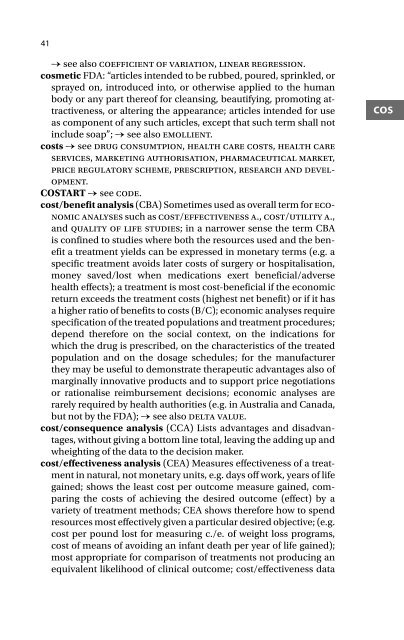220-Dictionary of Pharmaceutical Medicine, 2nd Edition-Gerhard Nahler Annette Mollet-3211898352-S
220-Dictionary of Pharmaceutical Medicine, 2nd Edition-Gerhard Nahler Annette Mollet-3211898352-S
220-Dictionary of Pharmaceutical Medicine, 2nd Edition-Gerhard Nahler Annette Mollet-3211898352-S
You also want an ePaper? Increase the reach of your titles
YUMPU automatically turns print PDFs into web optimized ePapers that Google loves.
41→ see also coefficient <strong>of</strong> variation, linear regression.cosmetic FDA: “articles intended to be rubbed, poured, sprinkled, orsprayed on, introduced into, or otherwise applied to the humanbody or any part there<strong>of</strong> for cleansing, beautifying, promoting attractiveness,or altering the appearance; articles intended for useas component <strong>of</strong> any such articles, except that such term shall notinclude soap”; → see also emollient.costs → see drug consumtpion, health care costs, health careservices, marketing authorisation, pharmaceutical market,price regulatory scheme, prescription, research and development.COSTART → see code.cost/benefit analysis (CBA) Sometimes used as overall term for economicanalyses such as cost/effectiveness a., cost/utility a.,and quality <strong>of</strong> life studies; in a narrower sense the term CBAis confined to studies where both the resources used and the benefita treatment yields can be expressed in monetary terms (e.g. aspecific treatment avoids later costs <strong>of</strong> surgery or hospitalisation,money saved/lost when medications exert beneficial/adversehealth effects); a treatment is most cost-beneficial if the economicreturn exceeds the treatment costs (highest net benefit) or if it hasa higher ratio <strong>of</strong> benefits to costs (B/C); economic analyses requirespecification <strong>of</strong> the treated populations and treatment procedures;depend therefore on the social context, on the indications forwhich the drug is prescribed, on the characteristics <strong>of</strong> the treatedpopulation and on the dosage schedules; for the manufacturerthey may be useful to demonstrate therapeutic advantages also <strong>of</strong>marginally innovative products and to support price negotiationsor rationalise reimbursement decisions; economic analyses arerarely required by health authorities (e.g. in Australia and Canada,but not by the FDA); → see also delta value.cost/consequence analysis (CCA) Lists advantages and disadvantages,without giving a bottom line total, leaving the adding up andwheighting <strong>of</strong> the data to the decision maker.cost/effectiveness analysis (CEA) Measures effectiveness <strong>of</strong> a treatmentin natural, not monetary units, e.g. days <strong>of</strong>f work, years <strong>of</strong> lifegained; shows the least cost per outcome measure gained, comparingthe costs <strong>of</strong> achieving the desired outcome (effect) by avariety <strong>of</strong> treatment methods; CEA shows therefore how to spendresources most effectively given a particular desired objective; (e.g.cost per pound lost for measuring c./e. <strong>of</strong> weight loss programs,cost <strong>of</strong> means <strong>of</strong> avoiding an infant death per year <strong>of</strong> life gained);most appropriate for comparison <strong>of</strong> treatments not producing anequivalent likelihood <strong>of</strong> clinical outcome; cost/effectiveness datacos


